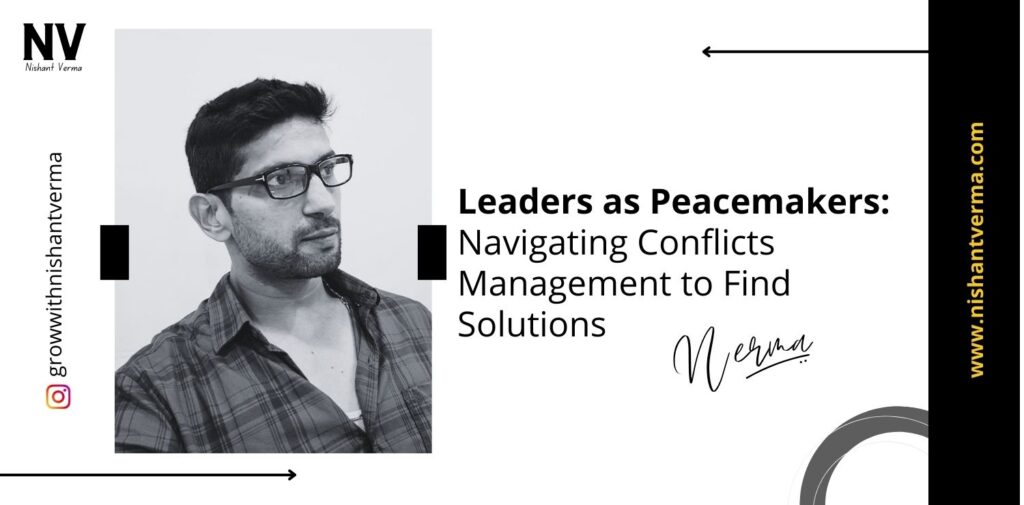Imagine leadership as a peacekeeper, turning stormy seas of disagreements into calm waters of solutions. This article will explore the simple yet powerful leadership and conflict management concepts. Join us to understand how leaders can navigating conflicts management, promote harmony, and guide their teams toward collaborative solutions.

I. The Reality of Conflict in the Workplace
Conflict is like a cloud that can sometimes shadow the workplace. It’s normal, and it happens when people with different perspectives and goals work together. Leaders must manage these navigating conflicts management to ensure a positive and productive work environment.
II. Why navigating conflicts management Matters for Leaders
Let’s keep it simple: Conflict management matters because:
- Productivity: Resolving conflicts prevents disruptions, keeping the team focused on their goals.
- Employee Well-being: A harmonious workplace fosters a positive atmosphere, benefiting the well-being of team members.
- Innovation: Addressing navigating conflicts management creatively can lead to innovative solutions and improved processes.
III. The Role of Leadership in Conflict Management
Leaders are like mediators in the conflict resolution process. Here’s how leaders contribute:
- Creating a Safe Space: Leaders establish an environment where team members feel safe expressing their concerns.
- Active Listening: Leaders listen attentively to understand the root causes of conflicts.
- Facilitating Communication: Leaders encourage open and respectful communication among team members.
IV. Types of Workplace Conflicts: Recognizing the Signs
Navigating conflicts management come in various shapes and sizes. Recognizing the signs helps leaders address them effectively:
- Interpersonal Conflicts: Between individuals with differences in personality or working styles.
- Task-related Conflicts: Arise from differences in opinions on work-related matters.
- Role Conflicts: Stem from unclear expectations or overlapping responsibilities.

V. The Conflict Resolution Process: A Step-by-Step Guide
Navigating conflicts management is like following a map. Let’s break down the conflict resolution process:
- Identification: Recognize the conflict and its impact on the team.
- Understanding: Dig deeper to understand the underlying issues causing the conflict.
- Communication: Encourage open and honest communication between the parties involved.
- Brainstorming Solutions: Collaboratively generate potential solutions.
- Agreement: Reach a consensus on the best solution.
- Implementation: Put the agreed-upon solution into action.
- Follow-up: Monitor the situation and address any lingering issues.
VI. Conflict Management Styles: Choosing the Right Approach
Leaders have different styles of managing conflicts. Let’s simplify a few:
- Collaborative: Encouraging open communication and seeking win-win solutions.
- Accommodating: Prioritizing maintaining relationships over winning the argument.
- Compromising: Finding a middle ground through negotiation.
- Competing: Taking a firm stand to resolve the conflict decisively.
VII. Communication Skills in Conflict Management
Communication skills is the key to resolving navigating conflicts management peacefully:
- Active Listening: Truly hearing and understanding the concerns of all parties.
- Effective Expression: Clearly articulating thoughts and feelings without blame.
- Non-Verbal Cues: Being aware of body language and other non-verbal cues.
- Empathy: Understanding and considering the emotions of others.

VIII. Building a Positive Team Culture: Preventing Conflicts
Prevention is like putting on sunscreen before going out in the sun. Leaders can prevent navigating conflicts management by:
- Clear Expectations: Communicate roles, responsibilities, and expectations.
- Team-building Activities: Foster a sense of camaraderie among team members.
- Regular Check-ins: Address potential issues before they escalate through regular team check-ins.
- Training on Conflict Resolution: Equip team members with conflict resolution skills.
IX. Case Studies: Real-Life Examples of Successful Conflict Management
Let’s draw inspiration from real-life leaders who effectively managed navigating conflicts management:
- Leader A: By facilitating a team-building workshop, Leader A improved communication, and reduced interpersonal conflicts.
- Team B: Team B, led by a conflict-resolving leader, successfully resolved a task-related conflict, resulting in a more efficient workflow.
- Organization C: Organization C implemented a mentorship program that reduced role conflicts and enhanced collaboration.
X. Emotional Intelligence in Conflict Management
Emotional intelligence is like a superhero power in conflict resolution:
- Self-awareness: Leaders understand their emotions and how they may affect the conflict.
- Empathy: Leaders put themselves in others’ shoes to comprehend their perspectives.
- Self-regulation: Leaders control their emotional responses to maintain composure in conflict situations.
- Social Skills: Leaders navigate social situations effectively, fostering positive relationships.
XI. Dealing with Difficult Personalities: A Leader’s Guide
Leaders encounter different personalities, and some may be more challenging in conflict situations. Strategies include:
- Remaining Calm: Maintaining composure, even in the face of challenging behaviors.
- Seeking Common Ground: Identifying shared interests to build a foundation for resolution.
- Setting Boundaries: Establishing clear expectations for respectful communication and behavior.
XII. Navigating conflicts management in Remote Teams: Adapting Strategies
In a remote work environment, leaders need to adjust their conflict resolution adapting strategies:
- Virtual Communication Tools: Leveraging technology for virtual meetings and discussions.
- Structured Communication Channels: Establishing clear communication channels for conflict resolution.
- Cultural Sensitivity: Being aware of cultural differences in virtual teams.
XIII. Overcoming Resistance to Conflict Resolution: Strategies for Success
Some team members may be resistant to navigating conflicts management. Strategies to overcome resistance include:
- Education: Providing training on the importance and benefits of conflict resolution.
- Fostering Trust: Building trust within the team to create a safe space for open communication.
- Leading by Example: Demonstrating the positive outcomes of conflict resolution through leadership actions.
XIV. Mediation Skills for Leaders: Resolving Complex Conflicts
Leaders can act as mediators in complex conflicts by:
- Remaining Neutral: Avoid taking sides to maintain objectivity.
- Active Listening: Truly understanding the concerns of all parties involved.
- Facilitating Dialogue: Encouraging open communication and helping parties find common ground.
XV. Conflict Management Training for Leaders: Enhancing Skills
Investing in conflict management training is like sharpening a tool. Leaders can enhance their skills through:
- Role-playing Exercises: Simulating conflict scenarios for practical skill development.
- Case Studies: Analyzing real-life cases of conflict resolution for insights.
- Continuous Learning: Staying updated on effective conflict resolution strategies and techniques.
XVI. The Future of Conflict Management: Embracing Change
As the workplace evolves, future of conflict management strategies must also adapt:
- Technology Integration: Leveraging technology for virtual conflict resolution and communication.
- Diversity and Inclusion Focus: Embracing diversity and inclusion to prevent virtual conflicts related to differences.
- Remote Work Challenges: Addressing unique challenges that arise in remote work environments.
Conclusion: Leaders as Architects of Harmony
navigating conflicts management is the conductor’s baton guiding the team toward harmony in the grand orchestra of leadership. As architects of harmony, leaders can turn disagreements into solutions, fostering a culture of collaboration and respect. Let’s build workplaces where conflicts are not seen as obstacles but as opportunities for growth, learning, and creating a stronger, more resilient team.




